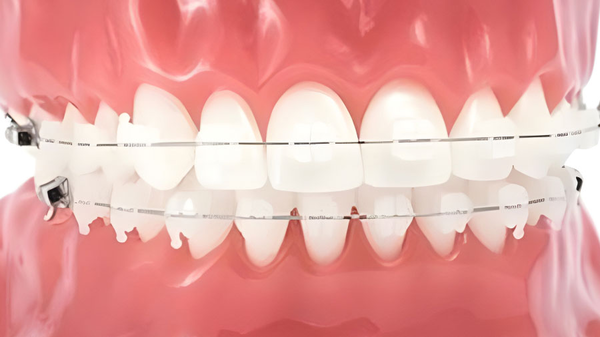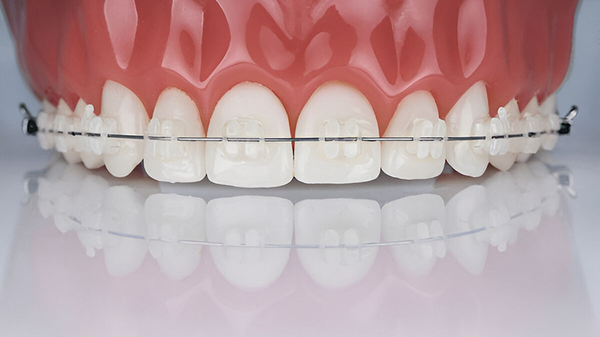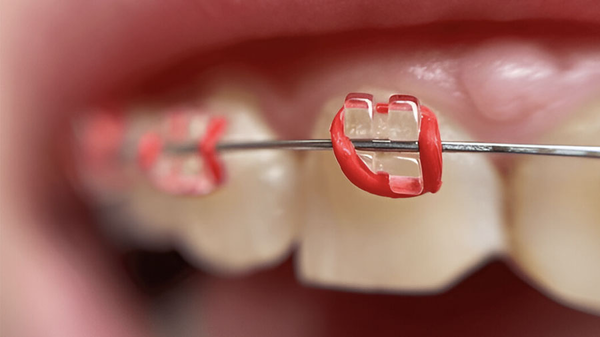Explore how Selective Laser Melting (SLM) is transforming cobalt chrome partials and removable prosthetics. A comprehensive expert guide for lab owners and prosthodontists, featuring clinical insights, workflow diagrams, pros/cons, and real-world applications.

Table of contents [Show]
- Introduction
- Why Cobalt Chrome Partials Still Matter
- Limitations of Conventional Casting for Removables
- What Is SLM Technology?
- How SLM Works: Step-by-Step Manufacturing Workflow
-
Advantages of SLM for Cobalt Chrome Partials
- Ultimate precision driven by digital design
- Superior mechanical performance
- Ability to create complex geometries not achievable with casting.
- Minimized porosity, reduced inclusion defects
- Consistent repeatability across large production batches
- Reduced labor and fewer technical variables
- More efficient material usage
- Biocompatible, nickel-free Co-Cr options
- Supports Dentistry 4.0 digital workflow integration
-
Disadvantages & Challenges of SLM
- High equipment and maintenance costs
- Residual internal stresses that require heat treatment
- Rougher initial surface finish compared with cast surfaces
- Slower production speed for large frameworks
- Build chamber size limitations
- Requires specialized training in CAD, print orientation, and SLM parameters
- Strict safety protocols needed for fine powder handling
- Conclusion
Introduction
Prosthodontics plays a central role in restoring missing intraoral and, to some extent, extraoral structures. The goal is to reestablish function, comfort, and esthetics for patients across a wide spectrum of clinical conditions. For decades, removable partial dentures have remained an essential treatment option, together with fixed prostheses, crowns, and implant-based solutions.
Since 1839, modern denture base materials have evolved to include acrylic resins, cobalt-chromium alloys, nickel-chromium alloys, pure titanium, and titanium alloys. Traditionally, cobalt-chromium (Co-Cr) denture bases have been fabricated using the lost-wax casting technique. This long-standing method has shaped conventional removable prosthodontics for generations. However, while casting has been regarded as reliable, it presents several important limitations. These include technique sensitivity, labor-intensive steps, shrinkage-related inaccuracies, surface and internal porosity, and inconsistent results across production batches. Such challenges directly affect one of the most critical determinants of RPD success: the adaptation and fit of the framework.

The introduction of Selective Laser Melting (SLM) has created a new direction in the fabrication of Co-Cr frameworks. By digitizing and modernizing the production workflow, SLM addresses many of the challenges associated with casting. The technique offers improvements in precision, mechanical performance, surface consistency, and reproducibility. As prosthetic workflows around the world, including those at XDENT LAB, continue to adopt fully digital manufacturing, understanding the capabilities, limitations, and clinical implications of SLM has become increasingly important for both laboratory owners and prosthodontists.
This article provides a comprehensive and evidence-based exploration of Cobalt Chrome Partials using SLM technology. It brings together scientific research, technical insights, comparative evaluations, and practical considerations. The aim is to support modern dental laboratories and clinicians in making informed decisions as the industry moves toward advanced digital prosthodontics.
Why Cobalt Chrome Partials Still Matter
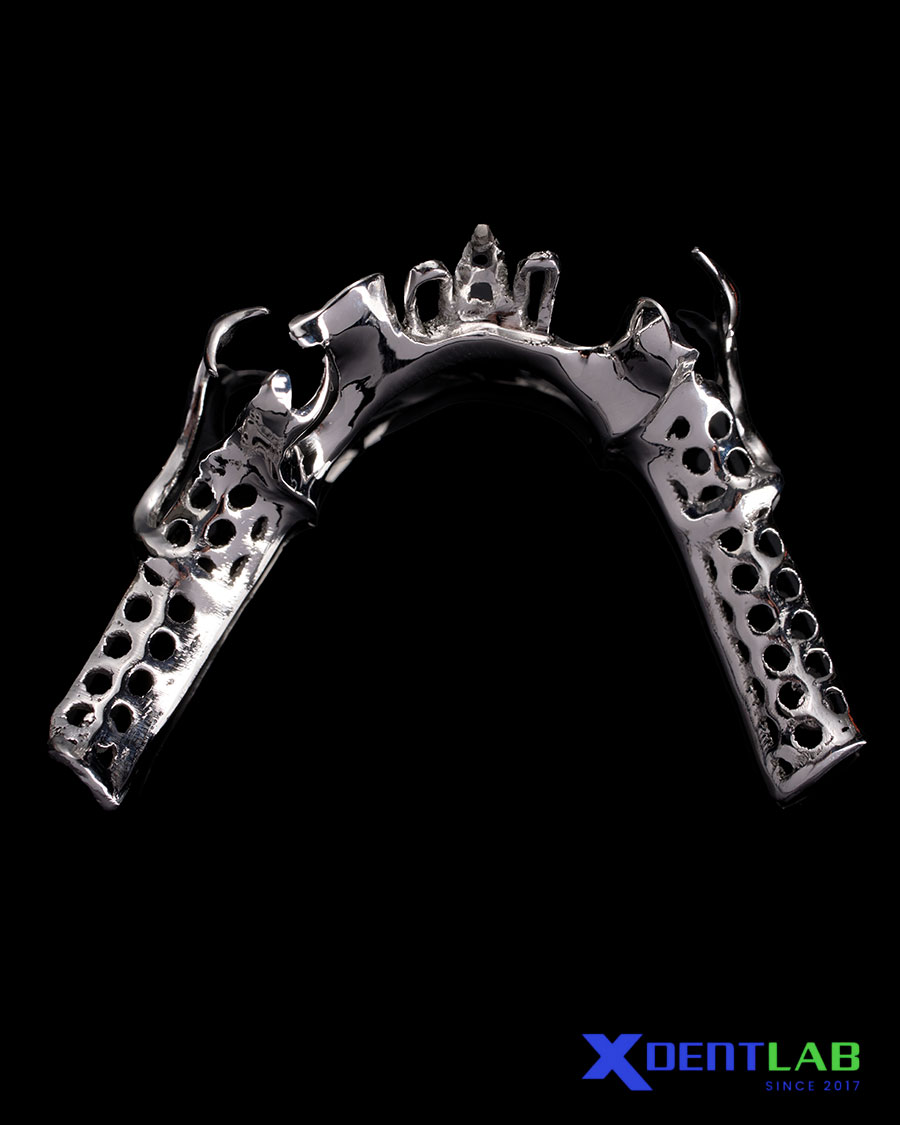
Despite the rise of fixed restorations and implant dentistry, removables remain indispensable because they are:
cost-effective,
repairable,
conservative to tooth structure,
adaptable to anatomical changes over time, and
suitable for medically or financially complex cases.
Co-Cr partials, in particular, offer excellent rigidity, corrosion resistance, biocompatibility, and longevity. Their performance, however, is heavily dependent on framework fit, an area where traditional casting often falls short and where SLM introduces a significant step forward.
Limitations of Conventional Casting for Removables
Although cobalt-chromium partials have been used for decades, the lost-wax casting technique presents several inherent limitations that directly affect the accuracy and long-term performance of removable partial dentures. Conventional casting is influenced by multiple variables, many of which are difficult to control.
Key limitations of traditional casting include:
Metal shrinkage during the transition from liquid to solid, leading to dimensional inaccuracies.
Distortion of wax patterns, especially during handling, investing, or burnout.
Expansion or inconsistency in investment materials, which affects the final fit of the framework.
Porosity, inclusions, and internal microdefects, commonly associated with casting of Co-Cr alloys.
Operator dependence, making reproducibility difficult across different technicians or batches.
Challenges in machining Co-Cr alloys due to their inherent hardness, increasing chairside adjustment time.
These limitations have direct clinical implications. Studies report that up to 76% of conventionally cast RPD frameworks fail to achieve optimal intimate contact at rest seats (0–50 micrometers), which compromises retention, load distribution, and long-term prosthesis stability.
The accumulation of these issues has driven laboratories to seek more predictable and digitally standardized alternatives. This need for improved accuracy and reproducibility forms the foundation for the transition toward additive manufacturing, particularly Selective Laser Melting (SLM).
What Is SLM Technology?
Selective Laser Melting (SLM) is an advanced additive manufacturing technique that uses a high-powered laser to selectively melt layers of cobalt-chrome powder according to a digital CAD design. Each layer is fused with high precision, resulting in a fully dense and homogeneous metal structure that replicates the digital model with exceptional fidelity.
In dental applications, SLM enables the fabrication of cobalt-chrome partial denture frameworks without the traditional constraints of casting. The process eliminates several conventional steps and their associated inaccuracies, including:
No wax patterns, removing distortion risk during handling or burnout.
No investment materials, avoiding expansion-related dimensional changes.
No casting defects, such as porosity, shrinkage, and inclusion errors.
By building the framework directly from a digital file, SLM provides a one-to-one translation of the design. This level of accuracy and consistency surpasses what is typically achievable with the lost-wax casting technique, offering laboratories and prosthodontists a more predictable pathway to optimal framework adaptation.
How SLM Works: Step-by-Step Manufacturing Workflow
Selective Laser Melting follows a precise digital-to-metal process. Below is the simplified and easy-to-understand workflow used in advanced dental manufacturing environments, including XDENT LAB.
Step 1. Digital Preparation (CAD Design)
The process begins with a detailed 3D CAD model of the partial denture framework. In this step, the technician designs all functional components, including:
major connectors
clasp assemblies
rests and minor connectors
mesh or lattice structures
After the design is complete, the CAD file is sliced into extremely thin layers (about 20–50 micrometers). These slices guide the laser during the printing stage.
Step 2. Powder Bed Setup
A thin, even layer of cobalt-chrome powder is placed on the build platform. This platform sits inside a sealed chamber filled with argon or nitrogen to:
prevent metal oxidation
protect the powder during melting
create stable, controlled conditions for laser fusion
This environment ensures the final framework is dense and free of contamination.
Step 3. Selective Laser Melting
A high-powered fiber laser scans across the powder surface and melts the areas defined by the sliced CAD data. Several key parameters must be precisely controlled, such as:
laser power
scanning speed
hatch spacing (laser path overlap)
beam diameter
These settings determine how well the powder fuses into a solid layer.
Step 4. Layer-by-Layer Construction
Once the first layer is melted and solidified:
the platform lowers by the exact thickness of one layer
a new layer of powder is spread
the laser melts the next pattern
This process is repeated layer after layer until the entire framework is built. Each layer bonds perfectly with the one below it, forming a fully dense, uniform cobalt-chrome structure with no casting shrinkage, porosity, or wax distortion.
Step 5. Controlled Cooling
After printing is complete, the framework cools slowly inside the inert chamber. Gradual cooling helps:
minimize thermal stress
prevent warping
maintain dimensional accuracy
This is especially important for thin connectors and delicate clasp areas.
Step 6. Post-Processing
Once removed from the powder bed, the framework goes through several finishing steps:
a. Powder Removal
Loose, unfused powder is eliminated using compressed air or ultrasonic cleaning.
b. Stress-Relief Heat Treatment
This reduces internal stresses accumulated during rapid melting and solidification.
c. Support Removal
Where required, small support structures are removed before finishing.
d. Surface Finishing
The framework is polished to achieve:
smooth fitting surfaces
reduced plaque retention
improved patient comfort
enhanced esthetic appearance
At XDENT LAB, standardized polishing protocols ensure both polished and fitting surfaces achieve a consistent roughness profile, in line with published research comparing SLM and conventional casting.
Final Outcome
The result is a high-strength, biocompatible cobalt-chrome partial denture framework with excellent accuracy and minimal adjustment time, precisely replicating the original digital design.
Advantages of SLM for Cobalt Chrome Partials
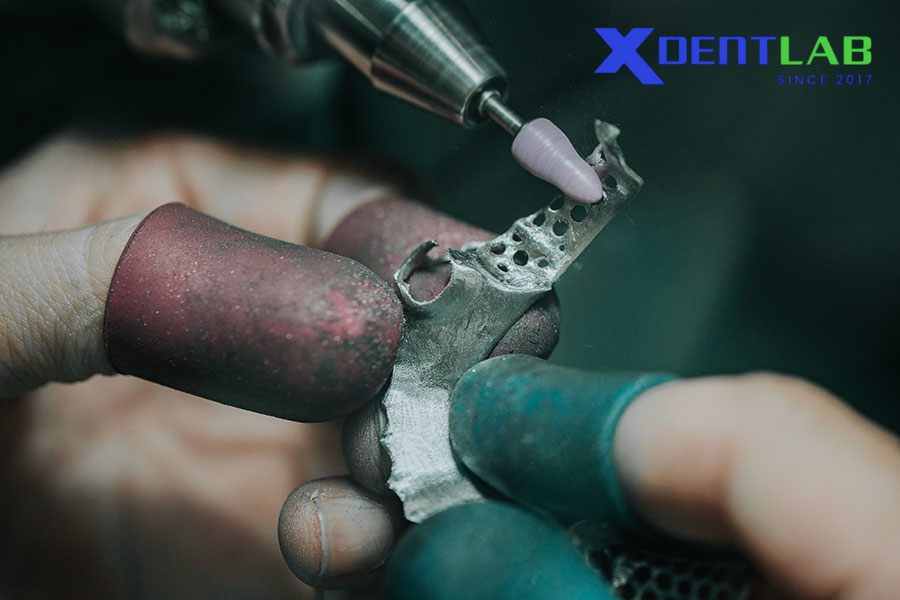
Selective Laser Melting offers several significant advantages when fabricating cobalt-chrome partial denture frameworks. Each benefit contributes to greater accuracy, reliability, and long-term clinical performance.
Ultimate precision driven by digital design
Because the framework is built directly from a CAD file, dimensional accuracy is far superior to conventional casting.
Superior mechanical performance
SLM frameworks exhibit higher strength, better fatigue resistance, and more uniform microstructure compared with cast Co-Cr.
Ability to create complex geometries not achievable with casting.
Undercuts, fine lattice structures, and delicate connectors can be produced with ease.
Minimized porosity, reduced inclusion defects
The controlled melting process greatly reduces internal voids that commonly occur in casting.
Consistent repeatability across large production batches
Digital workflows eliminate operator-dependent variability and produce predictable results case after case.
Reduced labor and fewer technical variables
SLM removes wax-ups, investing, burnout, and casting, simplifying the overall manufacturing process.
More efficient material usage
Because powder is selectively melted only where needed, waste is significantly reduced.
SLM powders often exclude nickel, providing a safer alternative for patients with metal sensitivities.
Supports Dentistry 4.0 digital workflow integration
SLM aligns seamlessly with intraoral scanning, CAD design, and cloud-based case management, supporting the shift toward automated digital prosthodontics.
Disadvantages & Challenges of SLM
Even with its clear benefits, SLM technology comes with real-world limitations that laboratories must be prepared to manage.
High equipment and maintenance costs
Industrial-grade SLM printers require substantial capital investment, regular calibration, inert-gas systems, and specialized maintenance. For many small and mid-sized laboratories, these costs can delay or prevent adoption.
This is where collaborative models with experienced partners such as XDENT LAB become valuable, allowing labs to access SLM fabrication without assuming the financial burden of purchasing and operating the equipment.
Residual internal stresses that require heat treatment
Rapid melting and solidification create thermal stresses that must be relieved through post-print heat cycles.
Rougher initial surface finish compared with cast surfaces
Additional polishing is needed to achieve clinically acceptable smoothness, especially in fitting areas.
Slower production speed for large frameworks
The layer-by-layer nature of SLM means bigger designs take longer to build.
Build chamber size limitations
Framework size is restricted to the dimensions of the printer’s build platform.
Requires specialized training in CAD, print orientation, and SLM parameters
Optimal results depend heavily on correct design, slicing, and parameter selection.
Strict safety protocols needed for fine powder handling
Co-Cr powder demands careful storage, ventilation, and PPE to ensure operator safety.
These challenges mean that SLM is not a simple, plug-and-play technology. Consistent excellence depends on disciplined workflows, validated parameters, and the technical expertise found in well-trained digital laboratories.
Conclusion
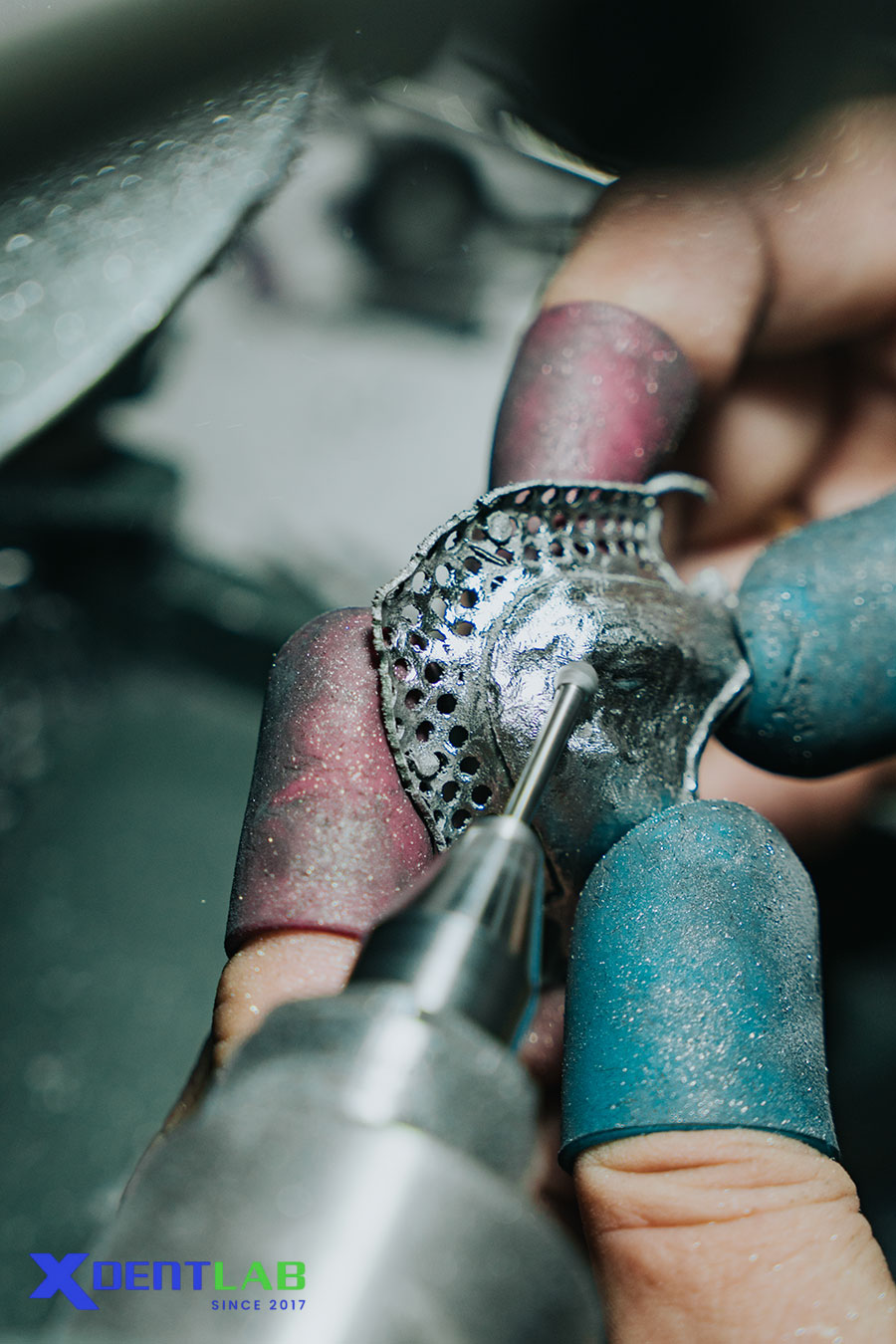
Selective Laser Melting represents one of the most meaningful technological shifts in the evolution of cobalt-chrome partial denture fabrication. For lab owners and prosthodontists, adopting SLM is not merely following a digital movement. It is a strategic investment in predictable precision, streamlined workflows, and more consistent clinical outcomes. By reducing manual sources of error and transitioning to digitally governed processes, SLM opens new opportunities for efficiency, scalability, and high-performance removable prosthetics.
However, SLM also carries a significant barrier to entry. Industrial-grade machines, inert-gas systems, maintenance requirements, and powder-handling infrastructure demand considerable capital investment. Beyond equipment, effective SLM production requires deep expertise in CAD preparation, build-orientation strategy, parameter validation, and post-processing. Laboratories that have already developed these competencies, such as XDENT LAB, offer a practical pathway for small and mid-sized labs to access this advanced manufacturing technology without taking on the full financial and operational burden.
Through collaboration with an experienced SLM partner, laboratories can expand their removable capabilities while preserving their competitive advantage. You remain the primary point of contact for your clinicians. You maintain your brand identity and client relationships. What you gain is the precision, consistency, and mechanical performance of SLM without the heavy investment in equipment, training, and infrastructure.
If you are ready to elevate your approach to cobalt-chrome partials and bring digital excellence into your removable portfolio, a long-term partnership with XDENT LAB is an effective and future-ready solution.
References:
XDENT LAB is an expert in Lab-to-Lab Full Service from Vietnam, with the signature services of Removable & Implant, meeting U.S. market standards – approved by FDA & ISO. Founded in 2017, XDENT LAB has grown from local root to global reach, scaling with 2 factories and over 100 employees.. Our state-of-the-art technology, certified technicians, and commitment to compliance make us the trusted choice for dental practices looking to ensure quality and consistency in their products.

Our commitments are:
100% FDA-Approved Materials.
Large-Scale Manufacturing, high volume, remake rate < 1%.
2~3 days in lab (*digital file).
Your cost savings 30%.
Uninterrupted Manufacturing 365 days a year.
Contact us today to establish a strategy to reduce operating costs.
--------❃--------
Vietnam Dental Laboratory - XDENT LAB
🏢 Factory 1: 95/6 Tran Van Kieu Street, Binh Phu Ward, Ho Chi Minh City, Vietnam
🏢 Factory 2: Kizuna 3 Industrial Park, Can Giuoc Commune, Tay Ninh Province, Vietnam
☎ Hotline: 0919 796 718 📰 Get detailed pricing
Share this post:

